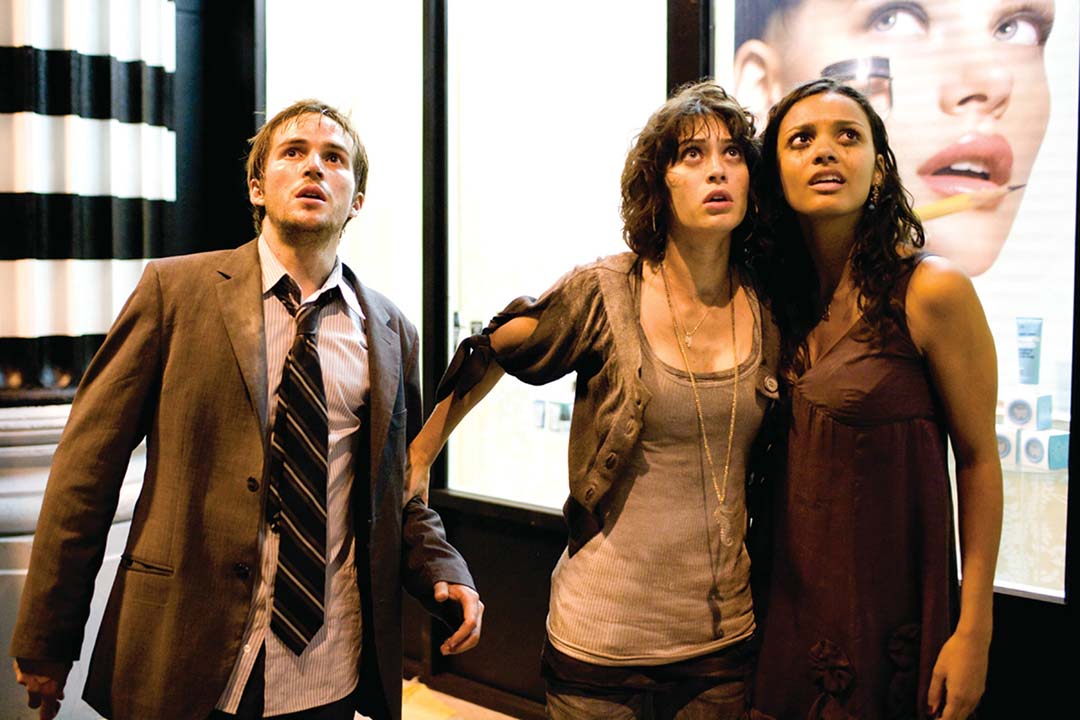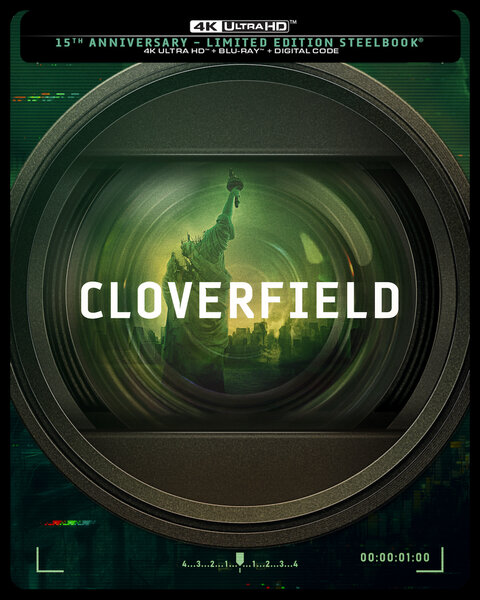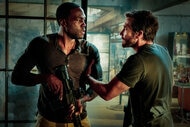Create a free profile to get unlimited access to exclusive videos, sweepstakes, and more!
Cloverfield at 16: Matt Reeves Recalls How They Pulled Off The Movie's Most Brutal Death
Director Matt Reeves looks back at the acclaimed found footage kaiju film.

The date is July 3, 2007. You just sat down in your local theater with a large bucket of popcorn, perspiring fountain soda, and a bag of Sour Patch Kids to enjoy Michael Bay's first live-action Transformers.
The lights go down and the first trailer comes alive on the screen. Shaky camera footage of a lively party in New York City is suddenly interrupted by explosions, screams, and a spine-tingling roar not of this world. All of the sudden, the head of the Statue of Liberty comes barreling down a Manhattan street, recalling the iconic poster for Escape From New York. Someone shouts above the mounting confusion: "I saw it! It's alive! It's huge!" Before you can get a bead on what's happening, the screen cuts to black, teasing that this mysterious Paramount project, whatever it might be, hails from producer J.J. Abrams and will open on Jan. 18, 2008.
RELATED: Mysterious fourth 'Cloverfield' movie from J.J. Abrams & Bad Robot finds director
No title, no clear plot — just a canvass of mass hysteria. The theater must have shown the wrong trailer, right? You're profoundly unsettled and wondering what the hell it is you just watched as the rest of the showing moves forward like nothing happened; like you didn't just see something that could have been a live feed of some kind of terrorist attack less than a decade after 9/11. That was the intended effect of a secret monster mash that leaned into 21st-century anxieties.
Such was the genius of Cloverfield (airing on SYFY this weekend), whose pitch-perfect utilization of Abrams' "mystery box" ethos launched an iconic guerrilla marketing campaign, the likes of which we may never see again. All the studio had to do was lay down a trail of cryptic breadcrumbs and fans did the rest, endlessly speculating online about what the monster might look like and driving excitement through the roof.
So much so that a found footage movie about a skyscraper-sized creature ravaging the Big Apple with its own immense size (and a terrifying swarm of spider-like parasites whose saliva makes you explode if it gets into your bloodstream) brought in nearly $200 million worldwide against a modest production budget of $25 million. A cinematic coup d'état for Abrams, screenwriter Drew Goddard, and director Matt Reeves. Sixteen years later, Cloverfield remains one of the highest-grossing found footage films ever made.
To celebrate the 15th-anniversary milestone last year, Paramount issued a Limited Edition 4K Ultra HD SteelBook version of the movie (now on sale) with legacy bonus features and brand-new artwork approved by Abrams and Reeves. SYFY WIRE caught up with Reeves at the time for a look back at the creature feature that gave America a memorable kaiju to call its very own.
I can’t believe it’s already been 15 years since the release of Cloverfield. That’s crazy. What about the film stands out to you all these years later?
It's the experience of making it, because I never had any experience in my career like the making of Cloverfield. When I first got involved, there was no script and I was saying to J.J., "Well, why don't I wait until Drew's done with the script?" And he was like, "Well, you can’t." And I said, "Why?" And he said, "Because we're shooting in 12 weeks, and that's just how this is happening." And I was like, "Oh, my God!" I had never done a VFX movie, I'd never done a genre thing like this — a giant monster movie.
All of it just felt like a seat-of-your-pants experience. Even the trailer was really a test to see if we could do a handheld movie, because they didn't know if they could track the handheld footage to do the effects. So everything was like, 'Gee, this could fail at every single moment.’ And then when that trailer connected when we put it out on Transformers, and suddenly people are going like, "Oh, my God! What is this?!" There was all that fear. That was exciting, but it was also terrifying because we were like a week-and-a-half into shooting. So the whole experience was just such an adrenaline rush. It's hard for me to believe that it was 15 years ago, that's just weird. But the thing that I remember is the way that movie looks, is the way that movie felt to shoot. That’s probably the thing that, for me, is really lasting, just the personal, visceral experience of making it. It was thrilling, but it was also kind of terrifying.
Speaking of the monster movie element, I still see videos on YouTube analyzing the creature. Did you ever have a definitive backstory for it?
For sure we did. Because you have to figure how to direct the monster, so to speak. So you have to understand what's going on with them emotionally. And for me, the big secret was that the monster was a baby and was experiencing separation anxiety. The reason the monster was freaking out is because they were having fits based on looking for their mother. And so, [the monster] was just as afraid as the main characters, because it seems like there would be nothing more terrifying than the human element fighting this giant monster element and, actually, both of them are just terrified. That's a mess. That's not good. So that part of it was absolutely something that we talked about in the development of the creature and in terms of how I shot it.
In terms of its species, was it of this planet or is it alien?
It’s alien. In fact, at the end of the movie, you can see the moment when it comes to [Earth]. It's another one of those little Easter egg moments, but when we revisit that footage where they’re on the Ferris wheel at the end, you can see the meteor flying down and hitting the ocean. That’s actually the beginning of the baby being on Earth.
I saw this film in eighth grade and one moment that traumatized me for life was Marlena’s death…
Oh, when she exploded? I’m sorry!
Not at all! It was traumatizing in the best way possible. What can you remember from shooting that scene?
I knew that the camera couldn't go on and off without reason, because then it would look like we were cheating. So shots continue that would be very hard to do on a low-budget movie because we're doing something like Children of Men where they've worked on something and rehearsed it for a week and then they do it and you're like, "Wow!"
We were doing like, "Okay, one of the soldiers needs to wipe and then that way, I can keep doing this thing where she explodes and do that for as many takes as we have." So at first, I did the part with the actors, and that part I knew was going to work, especially with [what] Lizzy [Caplan] did. It was really harrowing to hear her scream as they were taking her away. It was so shocking when the camera hits her and she's got the blood dripping from her eyes. And she's like, "I don't feel so good…" And you're like, "Oh, no!"
I knew the visceral part of that was working and then we ended up having this thing rigged from our physical effects people where we had the explosion of blood that comes up as she passes. Timing that and getting the right amount of blood and we only had so many takes — I think we only had like four takes — we happened to get one that worked. I think we supplemented it with a little bit of VFX, but it was one of those things where along the way you're thinking, "Is this gonna work? I hope it's going to work!" And then somewhere in post, you start going, "Oh I think it’s starting to work." Then we started showing it to friends and starting showing people (doing our super-secret screenings), and people started reacting to that. And you’re like, "Oh, thank God, it works."
The franchise ultimately lived on with 10 Cloverfield Lane and The Cloverfield Paradox. What’s it been like to see this property live on in an anthological format?
It's been really cool. It’s really fun to see what other filmmakers bring to it and what they want to do and an unexpected turn. Originally, when we were doing the movie, I think we were thinking that the three of us — me, J.J. and Drew — would do another one right then. And then we all got pulled in these different directions and it never came into fruition. So 10 Cloverfield Lane, and the whole idea of that, it opened up this whole other lane that was really, really exciting. For me, always exciting to see what other filmmakers do. That's been really gratifying and it's exciting to think about future iterations and what they could be. I can't talk about any of that, because it's Cloverfield and you never talk about Cloverfield. But it’s been fun to be a part of this.
The first Cloverfield very much played on post-9/11 fears. What would a new movie in this universe look like in the post-COVID era?
There’s no question it would be a viral movie, right? It would be about a virus. The funny thing about making that movie, like I said, for me, it opened up the idea of making genre movies and specifically about exploring your own feelings about things. I had such anxiety that was related to…I mean, I still have such anxiety. I think I wouldn't be a filmmaker if I didn't have anxiety.
Every movie that I've made is some sort of depiction of my internal anxiety … I think today, it would absolutely come from the uncertainty of what you can't see and the idea that being next to someone, you could catch something. There have been some really scary [viral thrillers]. Contagion is certainly really scary ... There would be a scary [Cloverfield] movie to do for sure about the spread of the virus.
Cloverfield airs on SYFY this Friday and Saturday — January 5 and 6 — at 11:30 and 2:59 p.m. EST. Click here for more scheduling info!
Originally published Jan 17, 2023.



























